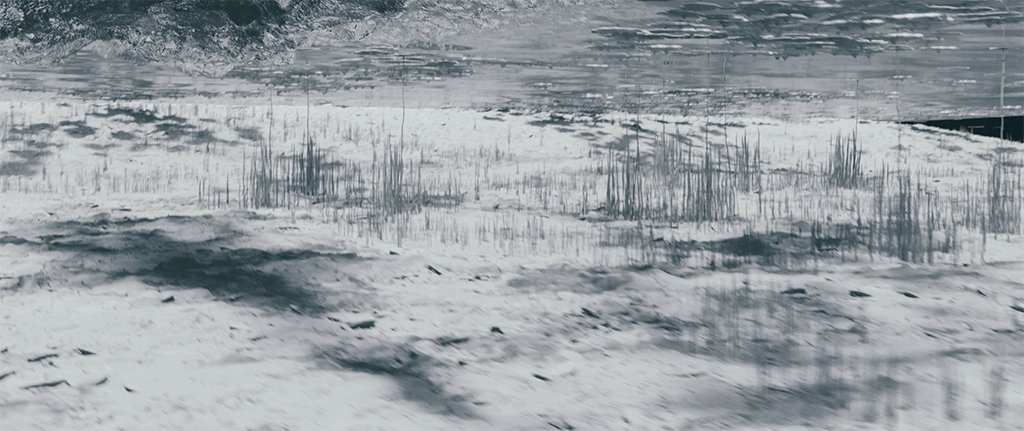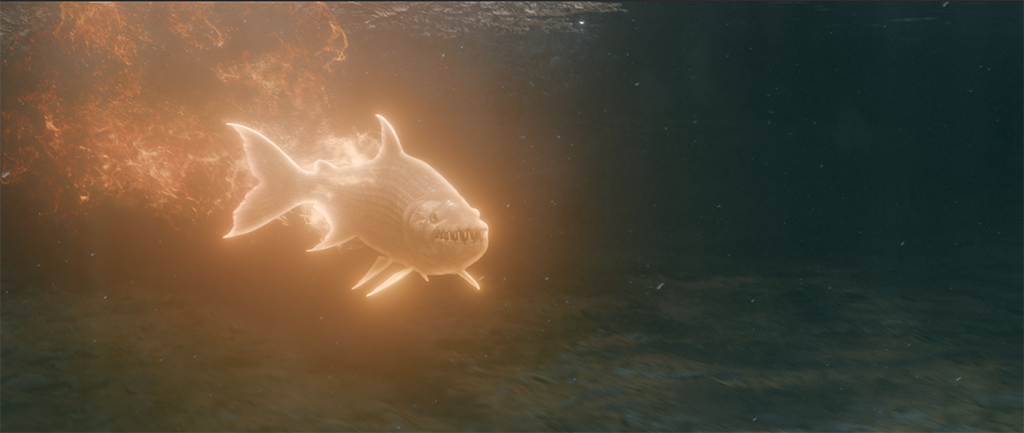By TREVOR HOGG
Images courtesy of Disney+.
By TREVOR HOGG
Images courtesy of Disney+.



The methodology for each visual effect shot was determined on a case-by-case basis.
Working on the Disney+ fantasy series American Born Chinese holds a special place in the heart of Visual Effects Supervisor Kaitlyn Yang (Raised by Wolves), because the content on the screen and the creative talent in front and behind the camera reflected her ethnic heritage in an authentic and meaningful way. The story reimagines the myth of the Monkey King by giving the trickster god domestic life troubles in the present day and mines the humor in trying to gain self-acceptance beyond the borders of China. There is no shortage of fantasy elements as a battle between the forces of good and evil ensues with two high school students thrust right in the middle of the heavenly conflict.
“In my opinion, visual effects are best served when it’s in a supporting role. They’re invisible or we tap into the magic realism whenever the visual effects need to be front and center because story calls for it.”
—Kaitlyn Yang, Visual Effects Supervisor




American Born Chinese wanted to make sure that everything was grounded with a focus placed upon magic realism.
“Just in the script phase, right off the bat you have a falcon changing into a tiger changing into a fish! How do we do that? That ultimately becomes the perfect handoff of what was shot practically and just seeing enough of something to whet your appetite. It was kind of a morph that was more into the sparkle-lighting effects realm aided by the sound design. The camera is moving so fast that you’re like, ‘Oh, now it’s going to happen.’ There were so many of those all in the row that was so mesmerizing to watch.”
—Kaitlyn Yang, Visual Effects Supervisor


The Monkey King is capable of 72 transformations, with one of them being a falcon.
“I was extremely thrilled when I got the email, and not having so many women visible I felt like I was chosen by the claw in Toy Story!” states Yang, who is the founder and CEO of Alpha Studios. “Having the braintrust [of Asian creators, heads of departments and cast] with lived experiences allowed us to know when to take liberties and pay homage,” Yang states. “You see so many nods to Asian traditions throughout the series. We had a lot of good ideas to pick from, and then figuring out which ones fit the tone and vibe that [showrunners] Kelvin Yu and Destin Daniel Cretton had already envisioned in their head and how to amplify that.”


Stunts were pivotal in pulling off the fantasy action sequences, with wirework being utilized by martial arts icon/Oscar winner Michelle Yeoh.
Having being responsible for Shang-Chi and the Legend of the Ten Rings, Cretton was experienced in dealing with a visual effects-heavy production while other directors were not as experienced, such as [director] Lucy Liu. “It was never that we are designing specifically for their vision,” Yang remarks. “They were always willing for new ideas and improvements, but key words were passed around here and there. Like any good storytelling, it’s about a feeling that you’re trying to capture. How fast was the waterfall moving and could that contribute to the intense dialogue that the dad and son are having? In my opinion, visual effects are best served when it’s in a supporting role. They’re invisible, or we tap into the magic realism whenever the visual effects need to be front and center because story calls for it.”


Determining the pacing and look of effects such as waterfalls was the desired tone for the scene.
Amongst the creative and technical challenges to produce 1,100 visual effects shots for the eight episodes was the ability of the Monkey King to do as many as 72 transformations, which are dictated by the scenario and where he has to go next. “Just in the script phase, right off the bat you have a falcon changing into a tiger changing into a fish!” Yang notes. “How do we do that? That ultimately becomes the perfect handoff of what was shot practically and just seeing enough of something to whet your appetite. It was kind of a morph that was more into the sparkle-lighting effects realm aided by the sound design. The camera is moving so fast that you’re like, ‘Oh, now it’s going to happen.’ There were so many of those all in the row that was so mesmerizing to watch.”


Among the invisible effects were smartphone screen inserts.
“The first and last episodes were always planned to be visual effects heavy. In Episode 108, we have this intense battle in the sky that we had to somehow make believable. There were so many moving parts, figuring out how to digitally duplicate something that we had practically. I started out as a special effects artist. I will always have a love of getting as much in-camera as possible knowing even if most of it doesn’t appear in the final frame that it’s going to be the coolest reference we’re going to have.”
—Kaitlyn Yang, Visual Effects Supervisor

The glass explosion was achieved practically.
For the opening chase in Episode 101 where a multitude of transformations occur, previs was produced by DigitalFilm Tree that was informed by Stunt Coordinator Peng Zheng. “He and his team shot at their practice ring on iPhones and mobile phones to give us a sense of the camera movement and how one scene stitched with another,” Yang explains. “That helped so many departments to visualize what do we need to do and where the handoff was. I hope that people will love the chase scene as much as we loved putting it together. That sequence, in particular, took the most days, shot count and budget. It was not only a fun sequence but set the tone for the rest of the season. That was one of the first sequences that we shot.” The transformation shots might be described as kung fun magic. “We didn’t do as many as 72 transformations, but perhaps for later seasons! Knock on wood! I grew up with Hong Kong cinema, so I love the types of choreography that you don’t see too much nowadays that have just enough surrealism and magic that ties it together. It’s so fast-moving you can’t look away,” Yang states.

Approximately 1,100 visual effects were created for the eight episodes.
“We took all of the tools in the toolbox and deployed them whenever we saw fit. In Episode 101, we LiDAR-scanned our sets knowing that we had to do extensive set extensions. We worked closely with the art department which had done extensive research and also relied on Gene Luen Yang, the writer of the book with the same name, because he has done extensive research.”
—Kaitlyn Yang, Visual Effects Supervisor
Most of the visual effects were temped by Pixelloid working alongside DigitalFilm Tree, “not necessarily to the degree of the final look that we ultimately settled on, but providing us with a stepping stone to keep improving upon,” Yang notes. “By cut five or six we were able to see some version of the effect already built in. The effects that went through the most iterations were probably for the Heaven episode. That was mainly shot on bluescreen, and we definitely used all of the time on the clock for that one to fine tune the lighting and matte painting. The first and last episodes were always planned to be visual effects heavy. In Episode 108, we have this intense battle in the sky that we had to somehow make believable. There were so many moving parts, figuring out how to digitally duplicate something that we had practically. I started out as a special effects artist. I will always have a love of getting as much in-camera as possible knowing even if most of it doesn’t appear in the final frame that it’s going to be the coolest reference we’re going to have.”


Nothing like having a battle between deities in a high school where teenage angst reigns supreme.
The methodology was devised on a case-by-case basis. “We took all of the tools in the toolbox and deployed them whenever we saw fit,” Yang explains. “In Episode 101, we LiDAR-scanned our sets knowing that we had to do extensive set extensions. We worked closely with the art department which had done extensive research and also relied on Gene Luen Yang, the writer of the book with the same name, because he has done extensive research.” Human Engine ran a portable scanning station on set to assist with the construction of digital doubles. “We had people flying into the sky or walking on water or cliff jumping. Even before wire removal and background replacements, watching the dailies was so cool. We were able to get some CG doubles, but for most of it we had an incredible stunt team that showed their homage to Asian cinema. Hopefully, the audience will be so immersed that everything we put on the screen will be taken as is, because the best compliment for visual effects is not to even know that it was there.”
Watch mesmerizing transformations of the Monkey King in DNEG’s “VFX Breakdown” for American Born Chinese. Click here: https://vimeo.com/844316668